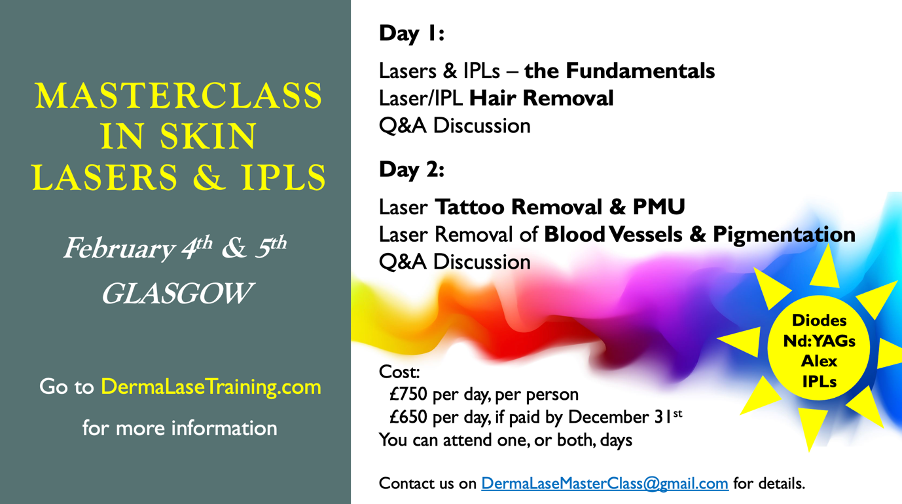Following on from my post of yesterday about the penetration of fluence into the skin, a few people were asking about the pain experienced by patients/clients.
I had pointed out that a single pulse of 30 J/cm2 is much more effective than three pulses of 10 J/cm2 – regardless of whether its from a laser or an IPL. So, I thought I should make this clearer…
Back to basics
In laser/IPL hair removal, we are trying to destroy hair follicles to minimise hair growth. To do that we must raise the temperature of the hair shaft melanin to a sufficient level and for a sufficient time such that the follicle’s germ cells are completely denatured (cooked!). In doing this, that follicle will not be able to regenerate since the germ cells are toast.
So, we need to fire an appropriate amount of fluence at the follicles to raise their temperatures sufficiently. Deeper follicles require higher fluences at the skin surface to ensure enough fluence reaches the deeper parts of the dermis.
The direct consequence of this is that the fluence must be chosen according to the depth of the hair (assuming it is a ‘dark’ hair).
If the chosen fluence is too low, it may only ‘stun’ the follicle which will leave some germ cells undamaged. These will proliferate when the next anagen phase occurs, and grow a new finer, lighter-coloured hair. Likewise, a low fluence may kill some of the more superficial follicles, but not the deeper ones.
This is simple physics!! (It’s not rocket science – I know, because I did a term of ‘rocket science’ in my astronomy degree course, many centuries ago!!)
Conclusion 1 – set the fluence according to the hair depth
This is critical in achieving good results. Most poor results are caused by a lack of fluence.
But…
This creates a problem. Deep follicles require higher fluences, but these will cause more pain. What is the source of that pain?
When light enters the skin it will traverse the epidermis and encounter the melanin in the basal layer (at the ‘dermal-epidermal junction’). This melanin will absorb some of the light energy – of course it will. After all, we are using the hair shaft melanin as the target!
So, the basal layer melanin will also become hot. The more melanin in there, the hotter it will become. It’s a straightforward relation – more fluence means higher temperatures (linearly!)
The thermal pain receptors (thermal nociceptors) are located just below the basal layer at the top of the dermis. If the basal melanin becomes hot, the pain nerves will send signals to the brain. The dermis background temperature is usually around 35ºC – the thermal nerves trigger at 45ºC. So it only take a 10ºC rise in their temperature to stimulate pain.
That is easily achieved with a relatively low fluence of red light energy! You can try it for yourself…
We don’t really want to induce pain in our lovely customers (most of the time!). So we need to reduce the chances of pain occurring by cooling the pain nerves as much as possible. If we cool them by 20ºC, then they will need to be heated by 30ºC to trigger the pain response. Even colder is better!
If you pick up an ice cube and let go of it after a few seconds, your fingers will not be very cold. However, if you hold an ice cube for 60 seconds, your fingers may become numb from the cold. So we need to apply this thinking to pre-cooling body sites – I don’t pre-cool for less than 60 seconds on any body area. That way, I know that the pain nerves should be properly cold.
If the target hairs are deep (as in the underarm and bikini areas) then I will pre-cool for longer – up to four or five minutes.
Darker skins have more basal melanin. They will become hotter, for the same fluence, compared with lighter skins. It’s inevitable!!
So, darker skins require MORE pre-cooling than light skins.
Conclusion 2 – set the pre-cooling timings according to the skin colour
Personally, I prefer ice-packs like the KoolPak. These can be kept in a freezer and applied straight onto the skin, wrapped in clingfilm. They stay cold for a reasonable length of time, which ensures that the skin is cold.
You can find them at ‘Koolpak.co.uk’. (No, I don’t get commissions!!)
In fact, it’s better the have your patients/clients complain about the cold, than the pain from the laser/IPL’s heat.
If, during a treatment, your client says that the sensation is painful, stop and re-apply the ice-pack. DO NOT turn the fluence down – that will reduce the success of the treatment.
Post-treatment
Most of the light energy we fire into the skin does not do the job we are asking of it. I calculated that less than 10% is actually hitting the hair shaft melanin. Most of it is creating heat throughout the rest of the dermis. This is unwanted heat energy.
It must be extracted as soon as possible, otherwise it may cause unintended tissue damage in the dermis. So, post-treatment cooling is required to minimise this damage. I usually recommend using the ice-packs for at least five minutes after the treatment. Apply them as soon as you can – don’t wait until the whole treatment is complete – that is far too late!
Summary
Choose the fluence according to the depth of the (dark) hair.
Pain is caused by a hot basal layer.
Pre-cool the skin sufficiently to minimise this pain.
Pre-cool darker skins for longer times.
Post-cool to extract the excess heat energy (up to five minutes).
My own experience is that we can use much higher fluences when the proper skin cooling is used, without damaging the skin. It really is simple thermodynamics (the ‘Zeroth Law’ if you are interested).
Higher fluence means better results – lots of cooling means less pain and less tissue damage.
PLUS – don’t start treatments at a lower fluence and increase each time your client/patient comes back for subsequent treatments. That is a bonkers idea!!! It is appropriate for laser tattoo removal, but definitely NOT for hair removal.
Hope this helps,
Mike.





In laser/IPL hair removal, the goal is to destroy hair follicles by heating them with light energy (fluence). The effectiveness depends on the fluence level and the depth of the hair follicles. Higher fluence is needed for deeper follicles, but this can cause more pain. Pain arises when the light energy heats the melanin in the skin’s basal layer, triggering thermal pain receptors. It’s a balance: too little fluence might only stun the follicle, leading to hair regrowth, while higher fluence effectively destroys the follicle but increases discomfort. In conclusion, setting the right fluence level is crucial for effective hair removal and managing pain. 🌡️🔬💡🔥🧑🔬💇♀️.
this is great advice! However, I do not know where to start with the higher frequency. We have a GentleMax Pro, and have always gone with the factory settings for initial treatments. For example, 18mm, 12 joules, 10ms for underarms. Is this fluence too low?
Hi Tanya,
Basically, yes! You need higher fluences to effectively
kill the follicles. But you must apply ice cooling too – the cryogenic system is not sufficient!
Mike.